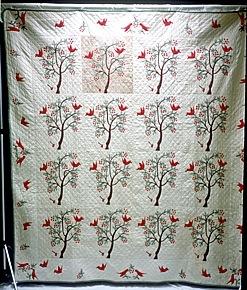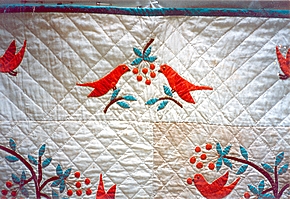Maggie Skipwith Smith: "Our George's Cherry Tree" Quilt
By John Corey Whaley and Susan Roach
with Documentation Information provided by Ann Jones, 2-19-89

In 1989, a quilt registry held in Baton Rouge documented Maggie Skipwith Smith's "Our George's Cherry Tree" or "The Tree of Truth" quilt-a remarkable quilt by a remarkable woman. The first woman elected mayor in Louisiana, Maggie Smith (12/12/1874-2/16/1957) served two terms from 1925-1929 as Mayor of Wilson, which she called the "greatest little town in Louisiana."
Smith's intention in making this quilt was to send it to the 1933 Century of Progress World Exposition. In handwritten notes she passed along with the quilt, she writes: "My object in designing it was to send [it] to the World's Fair in Chicago, thinking that should it win first prize, it would on presentation to the First Lady of the Land [Eleanor Roosevelt], remind her of the 'First President of the United States' and would have been made by the first woman mayor of Louisiana." Unfortunately, Smith did not arrive on time with her quilt in Memphis, where the Exposition quilts were being judged. Even so, when the quilt was returned to her, she learned that it had been awarded an "Honorable Mention" ribbon.
She notes that her quilt took "3,630 hours of constant sewing to cut, baste, put together, apply pieces, to quilt, and hem, so if a person sewing steadily for three hours a day, it would take them three and a half years to finish." According to her detailed calculations, she sewed 7,820 pieces: "920 cherries, 1218 leaves, 66 birds, 276 branches, 16 hatchets, 4988 cherry stems, 336 different parts of birds." These took over one-half million sewing stitches in addition to the quilting stitches. Smith writes that she quilted it in squares [crosshatching] because "Our George" was absolutely "on the square." In the border, surrounding the crosshatched squares, she quilts rows radiating out from the squares. She chose to use row quilting to represent roads because, in her words, "all roads leading from the square would lead to success." During the time she was making the quilt, Smith was often seen at ballgames, sitting in the car and working on it. In 1937, when she gave the quilt to Dr. Tom Jones, she wrote him a letter, in which she told him, "Only one thing I ask you to do is use it every day of your life." She added, "you may see a mistake or two, but just remember, 'no one is perfect-but a perfect fool,' and that each stitch is a kindly thought." This is purported to be the only quilt she made, although she did much needlework, such as clothes for her four children and ten grandchildren, as well as a table runner appliquéd with cherries made to match the quilt.
During her time as mayor, Smith enjoyed presiding over the mayor's court, and at one time gave two young residents a choice between serving time in jail and attending Sunday school for four months. Being mayor came naturally to Smith, whose two uncles were one-time governors of Virginia and Louisiana. A versatile woman with many interests, Smith, a sports enthusiast famous for her interest in young people, was called "Aunt Maggie" at LSU football games, which she drove 43 miles to attend. She boasted at 74 years of age that she had not missed a game in ten years. Reportedly, she also loved raising chickens, cotton, peanuts, and potatoes. At one time Smith turned over 129 acres of land in Wilson to the children of the town as a playground, complete with a lake, a skeet field, a baseball diamond, and horses to ride. She was married to Jodie R. Smith, a railroad engineer, and they had four children.




